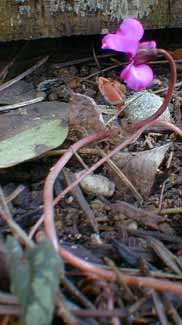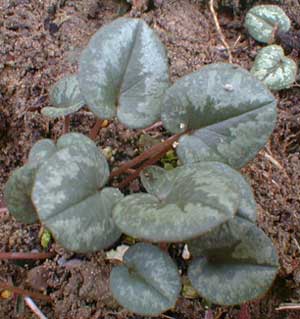 Cyclamen trochopteranthum:
Cyclamen trochopteranthum:
Wheel-wing Cyclamen
"First came the exotics, with ornaments rare,
The tall Miss Corcoris, & Cyclamen fair."
-Lydia Howard Huntley Sigourney
(1791-1865)
(1791-1865)
Anatolian or Wheel-wing Cyclamen (C. trochopteranthum) is placed in the "coum" group of cyclamens. It has "spidery" or windmill flowers; ours have a carmine-pink coloration much darker than the pink & violet of for other species growing in our gardens. It is closely related to & resembles C. parviflorum, but where parviflorum is diminuative in size, trochopteranthum is larger.
 Often the leaves are somewhat scalloped, but we have three small plants which all have smooth wide oval leaves without scalloping. One has scattered splashings of cream all over each leaf, except in the very center which is clear of markings. The other two are much more strongly of the "patternleaf" type with silhouettes of trees inside the pallid variagations. The leaves portrait from late October (2005) show the better-marked specimens. They are purple underneath.
Often the leaves are somewhat scalloped, but we have three small plants which all have smooth wide oval leaves without scalloping. One has scattered splashings of cream all over each leaf, except in the very center which is clear of markings. The other two are much more strongly of the "patternleaf" type with silhouettes of trees inside the pallid variagations. The leaves portrait from late October (2005) show the better-marked specimens. They are purple underneath.Ours develops a few leaves by October, more by November, & sends up tiny bright magenta buds by late November or early December, which open into full flower beginning mid to late January. The January (2004) photo above shows the very first full flower to appear in our garden on this seedling. It will likely be two more years before it is actually an impressive autumn & winter clump.
Throughout this time from autumn appearance of first leaves, up to late-winter appearance of the first flowers, the speckled leaves remain quite small & delicate of appearance, though gaining a little in size after the flower buds appear. The leaves appear to be more susceptible to snail attack than are C. coum & C. hederifolium because by the time the flowers were opening, the leaves are sometimes rather damaged.
The species does not like sudden changes in temperature or in moisture, so are usually grown in troughs or pots or alpine houses, though they are worth trying in open ground in Zone 8, where winters never quite test this species' limits. Ours have a sheltered location at the foot of an 'Oshio Beni' Japanese Maple.
When it experiences a frosty morning, it wilts down & looks momentarily poorly, but is actually fine, & when the temperature rises later in the day, the leaves rise up happily. One reason snails or insects get the leaves more easily, I suspect, could be because of this habit of laying down on the ground on a really cold day.
I had actually forgotten where this species' small round tan corm-like tubers were planted & I accidentally placed a decorative rock right on top of the first one I planted. When it was time for leaves to appear, was I ever surprised to see a these had spread outward to ten inches on abnormally long stems, in order to reveal leaves on three sides of the base of the rock, which I removed in autumn as soon as I realized my error. The cyclamen was ganglier than it's ever been since, but otherwise no worse for wear.
That it found its way out from under the rock suggests it's not actually all that sensitive, though by no means as hardy or as speedy to develop as C. coum. C. trochopteranthum is sufficiently delicate that the few that were in cultivation in the 19th Century died out of cultivation, in preference for much more garden-hardy species.
It was reintroduced to western gardening by collectors Peter Davis & Oleg Polunin in 1956, when it was still known as C. alpinum, then reclassified by Otto Schwarz in 1975 as C. trochopteranthum. Even today it is not widely grown except by the more avid enthusiasts.
Schwartz's reclassification named it for the flower's twisted propeller appearance, "trochopteranthum" meaning "wheel-wing flower." The strain presently in production & so most often gardened are descendants of the Davis & Olunin plants which have this striking feature. But when observed in the wild, it is not actually a uniform trait of a much more varied species.
As time passes other strains are bound to be introduced & "wheel-wing" may eventually appear to be partially a misnomer. But for the time being the twisted-bloom strain will prevail because because the Turkish government, attempting to protect wildflowers in their natural state, have banned the gathering of tubers or even the seeds, so that newly discovered wild variants cannot be legally obtained for further cultivation.
When grown from seed, they generally take three years to bloom. Our first one was greenhouse planted by the nursery 7/3/02 & was not a full year old when we put it in our garden. Even so it had many buds by early December 2003, beginning a couple weeks sooner than most of our C. coums.
January's full flowers will continue as late as April. They possess a marvelous odor about halfway between violets & honey, though unless grown in pots so you can lift them to your face, it is awfully hard to get down close enough to smell them.
Its native range is limited to southwestern Turkey, where it grows near the bases of trees in both coniferous & deciduous forests. It needs its tuber entirely covered but close to the surface, & placing it amidst the roots of trees or woody shrubs helps to duplicate the dry shade conditions it self-selects in the wild.
Continue to
Cyclamen coum 'Shell Pink'